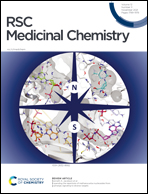Anti-amyloidogenic indolizino[3,2-c]quinolines as imaging probes differentiating dense-core, diffuse, and coronal plaques of amyloid-β†
Abstract
Abnormal deposition of amyloid-β (Aβ) is a major biomarker that is often used to diagnose Alzheimer's disease (AD). The Aβ plaque levels in the cortex and hippocampus are measured by either brain histology or positron emission tomography. Although cerebral plaques are found in several phenotypes, such as dense-core, diffuse, and coronal, imaging probes differentiating these plaques are currently unavailable. Here, we report that fluorescent indolizino[3,2-c]quinoline derivatives (YIQ) distinguish Aβ plaque phenotypes in brains of 5XFAD Alzheimer transgenic mice. We synthesized and screened 64 YIQ compounds through a series of in vitro and ex vivo Aβ staining assays. We found 20 compounds that could stain the Aβ phenotypes, 10 for dense-core plaques, eight for both dense-core and diffuse plaques, and two for solely visualizing only the coronal plaques while leaving the centric core unstained. Among the 20 imaging candidates, five YIQs displaying anti-Aβ aggregation efficacy were confirmed by thioflavin T assays and electrophoretic analyses.
![Graphical abstract: Anti-amyloidogenic indolizino[3,2-c]quinolines as imaging probes differentiating dense-core, diffuse, and coronal plaques of amyloid-β](/en/Image/Get?imageInfo.ImageType=GA&imageInfo.ImageIdentifier.ManuscriptID=D1MD00030F&imageInfo.ImageIdentifier.Year=2021)
- This article is part of the themed collection: NeuroMedChem


 Please wait while we load your content...
Please wait while we load your content...